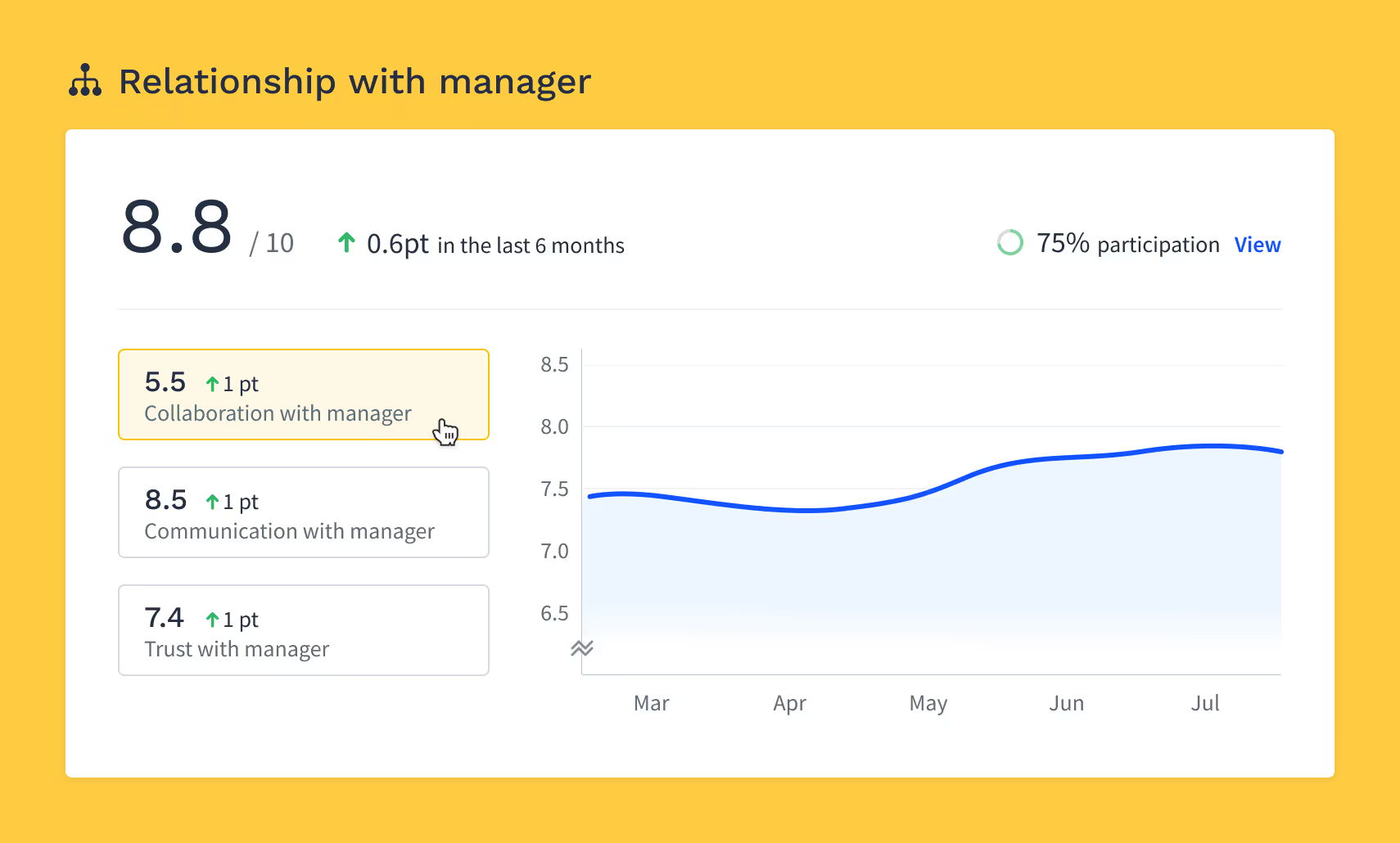Managing emotions in the workplace (employees’ and yours)

Discover Workleap Officevibe's benchmark report on 12 key employee engagement metrics

Can you remember a time when you received feedback you didn’t like, and immediately went into defense mode? Or a time when you lashed out because you were disappointed by an employee’s behavior, damaging your relationship? In a recent survey on emotions in the workplace, we asked a group of managers:
You might have guessed it — 100% of respondents said YES.
We’re all human, and emotional responses are only natural. But the goal is for the passion people feel at work to contribute to your team’s success, not hinder it. Learning to manage emotions — both your employees’ and your own — will help you better support your team, and each person in it.
The role of emotions in the workplace
Modern workplace cultures encourage people to be themselves, because that’s the best way to get their strongest ideas to the table and unlock their potential. It also makes more space for emotions in the workplace. And that’s great, but it also means that learning to regulate emotions and handle others' emotions are now key management skills. As Liz Fosslien and Mollie West Duffy explain in their book No Hard Feelings: The Secret Power of Embracing Emotions at Work:
In the year since the pandemic and grand exodus from our offices to remote work, emotions have run high. People are overwhelmed, feeling alienated, on edge, and facing burnout. And it's hard to gauge your team members’ emotions through a screen. Making space for emotions at work must be done responsibly, because emotions affect attitudes, team morale, employee engagement, and ultimately job performance.
[ov_cta id="5116616"]
Types of positive emotion and negative emotion
We asked a group of managers about workplace emotion, and their answers were mostly negative:
- Anger
- Defensiveness
- Frustration
- Impatience
- Stress
- Anxiety
- Self-doubt
- Insecurity
Many people's thoughts go to the negative when asked about emotions at work. But we also experience a lot of positive emotions at work, like:
- Excitement
- Satisfaction
- Accomplishment
- Happiness
- Confidence
- Inspiration
- Curiosity
- Empowerment
All these emotions affect how people do their work, collaborate, and contribute to the goals of their team and organization. When you learn to tap into both the positive and the negative, you’re developing emotional intelligence. And that means you can start to see how human emotion can be used for better decision-making and results.
How to tap into employee emotions in the workplace
So how can you harness positive emotions and manage negative emotions on your team? Here we go over some tips and tactics for creating an emotional culture that benefits your team.
Outline team values and principles
A clear set of guiding team principles helps everyone align on the shared values of the group and builds psychological safety. Schedule a meeting or create a space where team members can share ideas asynchronously. Have everyone share their input on post-its (try a virtual whiteboard), then cluster common points.
Team principle brainstorm questions
- What are we doing well as a team?
- What are we not doing well?
- What are our ideas for improving the way we work together?
- What are our shared values?
- What team principles can we set to represent the output of this brainstorm?
{emphasize}
In action: You can refer to these principles when an emotional outburst causes conflict or blocks productivity. Or, they can encourage people to embrace and reinforce positive emotion. For example, “we lose as a team” could be brought up if a team member blames someone else for a mistake. “We win as a team” could support the decision to schedule a long lunch to celebrate an accomplishment.
{emphasize}
Have regular one-on-one meetings
The more one-on-one communication you have with each member of your team, the more you’ll be able to read their emotional expression. Plus, one-on-one meetings keep you up to date with what’s motivating employees or blocking their success, and their level of job satisfaction. These conversations help you uncover their emotions and offer a safe space for people to open up about their mental health or personal life.
One-on-one questions to ask for an emotional check-in:
- What motivates you to come to work?
- What makes you uncomfortable at work and, as a result, prevents you from concentrating on a given task?
- Can you give me concrete examples of stressful situations you experience at work?
- What are you loving from our current remote work context?
Plan one-on-one agendas quickly and simply with the questions above and dozens of other suggested talking points in Officevibe’s one on one software. Agenda planning is shared with employees, so they can bring up their own thoughts or workplace feelings.
[ov_cta id="5108557"]
Collect and share 360 degree employee feedback
Peer-to-peer feedback, or 360 degree feedback, helps your team members understand what their colleagues appreciate most about their work. It also highlights areas where their peers see opportunities for them to grow. This alleviates people’s assumptions about how they’re perceived and empowers them to leverage their strengths and challenge themselves. Collect 360 degree feedback anonymously or not, and share the output in one-on-one meetings with each team member.
360 degree feedback questions:
- What should X keep doing?
- What should X stop doing?
- What should X start doing?
- How has X positively contributed to the team’s culture?
- What can X improve in their contribution to the team dynamics?
- Any other thoughts to share?
Examples of when to manage your emotions at work
People management can be tough. According to our survey on managers' emotional experience at work, negative feelings stem from:
- The pressure you put on yourself as a manager
- Difficult situations with employees
- Difficult situations with your boss
- Difficult situations with other managers
Here are some tactics for managing your emotions in these situations.
The pressure you put on yourself as a manager
It's natural to feel some pressure as a manager, but this pressure often comes from within. Try empowering yourself instead of putting pressure on yourself. When you do that, you break down feelings of insecurity or imposter syndrome and make room for professional success.
Tips to empower yourself in your role:
- Seek out mentors in your field.
- Start co-development sessions with other managers, where you all share experiences and learnings.
- Ask your manager and employees for feedback on your performance. You might be pleasantly surprised, and any criticism will only fuel you to improve.
Collect feedback from your team on an ongoing basis with an anonymous feedback tool like Officevibe. The software helps you get an honest look at how your team members feel about your leadership, and surface pain points so you can take action where they really need it.

Difficult situations with employees
Every manager faces difficult situations with employees, like addressing disruptive employee behavior or even letting someone go. It’s natural for you and your team member to have an emotional reaction when that happens, but it’ll be easier to handle a difficult conversation with tools for emotional regulation.
The SBI framework
Radical Candor’s SBI Framework helps you discuss situations objectively. It’s particularly helpful when emotions run high during difficult conversations. Break down the information you need to share using the framework:
- Situation: Give as much context as possible.
“Last Thursday was the deadline for the report to be submitted.” - Behavior: Describe the behaviors you observed without assumptions.
“Your report was submitted on Friday, and it was incomplete.” - Impact: Explain the specific impact of their behavior on you and the team.
“This caused frustration amongst our clients and resulted in the team not meeting its goals.”
Difficult situations with your boss
One of the toughest parts of management is acting as the go-between for your boss and your team. Priorities and approaches don’t always align, meaning you’ll need to advocate for your team and manage up.
How to manage up
- Know what speaks to your boss, whether it’s showing numbers, giving examples, asking questions, making compromises, or providing options.
- Go into the conversation with an open mind and respect your manager’s experience and expertise. Remember that you’re on the same team.
- Think about how you would want your employees to approach you. Use that as a starting point to approach your boss.
- Express your needs and the needs of your team clearly and objectively. Point to how they can help, and explain what will happen if these needs aren’t met.
Difficult situations with other managers
Every manager has their own objectives, motivations, and challenges, and that can cause tension. Keep your cool with the tips outlined below.
How to keep your cool when tensions are high
- Remember that others may not have the same context as you. Be willing to explain ideas further or go into more detail on objectives. Be patient.
- Ask for a breather! Go for a short walk, splash water on your face, or grab a snack. Look at the big picture and come back to the conversation with a fresh perspective.
- If you say something you regret, pause and say “sorry, that didn’t come out right, let me rephrase that.”
Repair and reflect after the fact
If you didn’t succeed at controlling your reaction in a heated moment, take time to reflect on it and admit where you went wrong. It’s not too late to turn what happened into a learning moment, especially if this is a recurring behavior pattern for you.
Reflection questions:
- What really triggered you, and why? Unpack it.
- How might you better see something like this coming in the future?
- What is another way that you could have acted? Write it down so you have a goal for your next conversation.
On a team filled with passionate employees who give their all and show up as they are, emotions are to be expected. Tapping into those emotions and finding ways to make them productive is how the best managers drive team success.
Special thanks to our coaches Simon Chauvette, Dena Adriance, Laure Vessier, and Eric Charest for their thoughtful insights.
Give HR and managers the clarity, confidence, and connection to lead better every day.


%20(1).avif)


.avif)
.avif)








